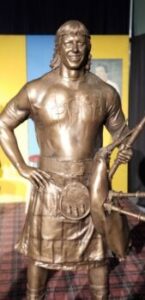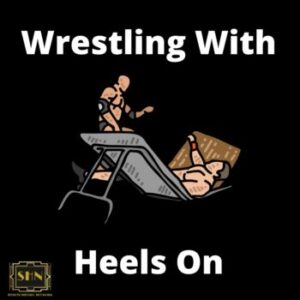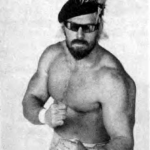When WWE television commentator Jim Ross told the millions of fans watching the OVER THE EDGE pay-per-view event, “THIS IS NOT PART OF THE ENTERTAINMENT HERE TONIGHT. THIS IS AS REAL AS REAL CAN BE HERE,” the veil that shades what is real in wrestling from reality, as the rest of us know it, was lifted.
Did Owen Hart Death Stop the Show?
Shortly after the accident in the ring, with all the gravitas befitting the circumstance, Jim Ross announces Owen Hart had died from his unharnessed 78-foot fall into the ring. One would think the tragedy of a 34-year-old husband and father of two plunging to his death before a live audience at the Kemper Arena in Kansas City, Missouri would be enough to bring the show to a screeching halt, but it was not.
Wrestlers continued fighting each other on the still bloodstained mat as if nothing disastrous had happened mere minutes before their matches. Whether or not these grapplers knew of Owen’s death makes not a bit of difference. They had received their marching orders. The show must go on.
This was a missed opportunity for the WWE and its owners to show some much-needed compassion to Owen’s family, friends, and fans. Why not stop the event in its entirety and own up to reality? Why not break from the wrestling storyline to acknowledge the passing of a fellow wrestler, a fellow human being? Why not say no to the invincible powers that be, and stand in the ring united for a fallen comrade? What a moment of solidarity that would have been, huh?
Okay, you’re not a sport, you’re sports entertainment. Well, what about entertainment? If I’m watching a Broadway show and the actress dies on stage during the performance, I know I don’t want to sit through the rest of it. Damn it, someone has to admit what has happened. I can certainly suspend disbelief for the run of a show but I cannot deny reality when reality rears its ugly head. It is in my face.
It is in your face. Let it give you pause as Jim Ross gave us pause on the night of Owen Hart’s death. I believe Owen Hart’s widow, Martha, said she was appalled by the fact that the pay-per-view event went on in the face of her husband’s death. I agree with her, appalling.
How Did Owen Hart's Death Effect Me?
On the night of Owen Hart’s death, May 23, 1999, I tossed and turned in a fit on my futon, unable to sleep. I hadn’t even seen the event for myself. I heard about Owen’s death from a friend because I couldn’t afford cable television. In 1999, I was 27 years old, living on my own for the first time in a studio apartment in Dyker Heights, Brooklyn, working for peanuts as a fraud investigator for the NYC Department of Homeless Services.
The whole time I tossed and turned I thought not just about Owen, but Owen’s older brother Bret, and what he must have been feeling. I have a younger brother and my thoughts couldn’t help but go to the devastating heartbreak of losing a sibling.
I couldn’t even begin to imagine his pain because nobody can imagine anyone’s pain and no one can say I think that’s what Owen would have wanted when they make excuses for them to carry on as if nothing has happened, as if someone’s death is just a bump in the road.

I Thought of Hogan and Belzer
While I tossed and turned on the futon, the thought of Owen’s death led me to the thought of comedian Richard Belzer. The Belz, as he was known then, had his own show in 1985. And on one of those shows, Belz had Hulk Hogan and Mr. T on as his guests.
There to promote the first-ever WRESTLEMANIA, T. and Hogan were full of the same bombastic energy they usually displayed on TV shows and wrestling promos. That should have been a warning to Belz not to ask Hogan to demonstrate a wrestling move on him, but he did it anyway.
In front of the live studio audience, Hogan put Belzer in a front chin lock and proceeded to apply pressure. Watching the YouTube video of this maneuver, I could actually hear Belzer’s neck CRACK as Hogan wrenched upward, lifting Belzer’s feet slightly off the ground, then dropping the lanky sunglasses-wearing Belzer to the stage floor, where he lay motionless for about thirty seconds to the studio audience’s audible dismay before Hogan roused Belz with slaps to the face and one quick pull on Belzer’s arm to get him to his feet.
Still in shock, and not missing a beat, Belzer hops up and says “We’ll be right back after these messages from you know who.” The segment cuts to a commercial but you can clearly see the smattering of blood on the collar of Belzer’s suit jacket as he turns his back to the camera and heads backstage. The blood came from the splitting of Belzer’s head when it smacked the hard wooden stage floor after Hogan released him from the sleeper hold.
So many years later, we are all hip enough to kayfabe—pro wrestling’s attempt to make everything in its world seem real—to know that wrestlers like Hogan sometimes went out of their way to make wrestling appear real to all the non-believers out there (thin and tall comedians and pornstached reporters being the worst of all the non-believers).
We now know how adamant wrestlers were about defending the pretense, upholding the lie. If anyone went about questioning wrestling’s veracity, they were sure to meet with some physical proof to teach him or her otherwise. There was no greater evidence of that approach than the physical attack on 20/20 reporter John Stossel.
Dr. David Schulz Slaps Slossel
I did not want to think about that particular incident, but my mind was on a roll as it always is when I want to go to sleep and can’t. Thinking about Belzer led to thinking about Stossel and then my brain was on a loop.
Here’s the loop:
Stossel tells Dr. David Schultz he thinks wrestling is fake. Offended by Stossel’s remark, Dr. D. says: “You think it’s FAKE?” then whips a swift SLAP to the side of Stossel’s head. The stunned Stossel gets up off the floor, barely maintaining eye contact with Schultz as Schultz says: “What the hell’s wrong with you? That’s an open-handed slap. Huh? You think it’s fake?” Schultz SLAPS Stossel again (harder than the first time). Coming to his senses, Stossel finally decides to run before Schultz can open-hand SLAP him a third time.
In an interview with THE TITLE MATCH NETWORK titled WHY I SLAPPED John Stossel on 20/20 “Dr. D” DAVID SCHULTZ claimed VINCE McMAHON ordered him to stay in character and “BLAST” Stossel because he was “making a joke of the business”. Schultz said McMahon was pleased with his handiwork: bitch-slapping a pesky reporter who dared question the veracity of the wrasslin’ biz.
To hear Schultz tell it, McMahon had not only ordered the attack on Stossel but had also gone out of his way to implicate Schultz as a serial attacker of reporters. It’s an interview that reveals a lot about how far wrestling (and in particular Vince McMahon) would go to protect the verisimilitude of the sport. That is until it became sports entertainment, only one year after the slap heard ‘round the world.
Was WWF A Sport?
The sports entertainment moniker appeared after 1989, when a WWF (as it was known then) official went on the record before the New Jersey State Senate to say wrestling was not a true athletic contest but pure entertainment, scripted like any other TV or radio show. With that testimony, the Senate deregulated wrestling in New Jersey, and other states followed suit. So now it could be told: wrestling was fake–no two ways about it.
Did this stop me and millions of other fans from watching? No way! If anything, it gave us all even more justification for watching. We were watching for the athleticism of the wrestlers and the operatic storylines.
While Vince McMahon was probably more interested in avoiding the taxations of state athletic commissions and the legal ramifications of the Stossel debacle than coming clean about wrestling, he had to have felt some relief about not having to lie about the “sport”, just as it was a relief for the fans. Wrestling’s entertainment value could be lauded instead of constantly defended.
Rowdy Roddy Piper Gets Real
It didn’t take long for other wrestlers to come forward about the fakery of their art, while others continued to toe the party line that wrestling was as real as the open-handed palm to your ear and still others tried to have it both ways. In his autobiography “IN THE PIT WITH PIPER”, ROWDY RODDY PIPER wrote: “I was Roddy Piper.

Nothing about me or my life was a show. Professional wrestling is not phony. The outcome may be predetermined, yes, but how you get there…”
And I totally get that because you can be truthful about doing something that isn’t true. Sounds like something out of method acting but it makes sense that those are real tears on stage even if the context for the crying is pure artifice. So yes, Rowdy Roddy Piper is no phony and what he does is not fake.
Roddy Piper and Superfly Snuka
Thinking about Roddy, and still struggling to get to sleep, I thought about the infamous feud between Roddy and SUPERFLY JIMMY SNUKA, or rather, the catalyst for their feud. It’s 1984. In three years, MORTON DOWNEY Jr. will pretend to pioneer the “trash tv” format, berating his guests and resorting to fisticuffs when necessary.
But for now, there’s only ROWDY RODDY PIPER and his WWF weekly interview segment where he interviews other WWF wrestlers, but also insults them and attacks them in the process.
Jimmy “SUPERFLY” Snuka was Piper’s guest on March 28, 1984. During this segment, Piper denigrated Snuka’s Fijian ancestry with incessant putdowns about Fijian women and Fijian culture. Fed up with the insults and the actual bananas Piper was hurling at him, Snuka rose to his feet to put his mic down and square up with Piper when Piper CRACKED a coconut on the back of Snuka’s skull, causing Snuka to CRASH into the PIPER’S PIT set piece.
While a sprawled-out Snuka struggled to get to his feet, Piper removed his kilt belt and began whipping Snuka’s back. Between lashes to Snuka’s back, Piper yelled: “Come on, boy!” and an ugly scene got even uglier. By the time the bloodied and ballistic Snuka got to his feet and ran toward Piper, Piper had managed to flee behind a steel door he shut behind him.
Just like any cool villain would, right? Then a gaggle of WWF officials and wrestlers kept their distance from the enraged Snuka, who looked like he could tear through the steel door at any moment to get to Piper.

I was 12 years old when I saw that Piper’s Pit segment and I never forgot it. At the time, I wasn’t sure if wrestling was real or not, but I was leaning more toward it being real. The Piper’s Pit segment tilted me in that direction. It was that convincing.
The Dr. D David Schultz slap was less convincing. Even then, as a kid, my intuition was Schultz was CRAZY, yes, but definitely laying it on thick–definitely out to prove a point. Which, in turn, made it feel less authentic than Piper’s assault on Snuka. Funny how that turned out because I still have a harder time watching the Piper’s Pit segment on YouTube than the Stossel slap.
The gullible little 12-year-old I was at the time watched the 5’0clock evening news, the six o’clock news, the 10 o’clock news, and the eleven o’clock news broadcasts that Saturday to catch any news reports about what Piper did to Snuka. And, of course, there were no news stories about the cocoanut headshot. Not even on the sports segments. Come on Warner Wolf! A man’s head is split open with a coconut and you have nothing to say about it?
I remember telling my father what Piper did to Snuka and my disappointment that there wasn’t one mention of it in the news. Trying to console me, my father explained that there were so many subway slashings going on in NYC that the news couldn’t focus on the cocoanut attack. Maybe they’ll mention it on the Monday newscasts was all he could offer.
And with those words, I continued to watch the news all week, learning a lot about local city politics and baseball standings in the process, but zippo about the cocoanut attack.
What Did Owen Hart Think Before His Death?
As the 27-year-old tossing and turning on his futon, I thought about what Owen Hart might have been thinking as he was strapped to the zipline meant to send him sailing into the ring for a grand entrance. Was he scared? Was he confident? Did he trust the WWE had his best interest in mind?
How much did he trust those in charge of the harness rigging? Was any of this even worth it, in terms of the entertainment value for the audience or would this be just another blip on the radar waiting to be erased by the next big title match? The next big thing?
The common thread running through these thoughts is the trust, faith, and belief that Owen, Belzer, Stossel, and even Snuka had in wrestling, or at least that entertainment would win out in the end. We’re all in the same line of work, aren’t we? It’s all showbiz, isn’t it?
Hulk Hogan’s not going to really choke me out, babe. Dr. D. might go hillbilly on me but he’s going to commit career suicide and hit a reporter on a nationally televised news magazine. The brutha’s got a real coconut in his hand but he’s not crazy enough to…oh yes he is. He’s no phony and the cocoanut shot might keep me from standing trial one day. One too many to the head the lawyers will say.
So what happens when entertainment goes out of its way to defend itself? When it crosses a line that’s already blurred? Must the show always go on? Sports Entertainment should have been a liberating moniker for fans and Vince alike.
As sobering as Jim Ross’ acknowledgment of Owen’s death was, pro-wrestling (or at least the WWE brand of wrestling) couldn’t find a way to address reality the way it once did when it was threatened by state athletic commission regulations. Maybe if there was a way to tax self-preservation and callousness prior to Owen’s death, the WWE would have been more sensitive to wrestling fans, Owen’s family and friends, and his memory.
Does any of this matter? I don’t know. What I do know is it’s time to take these heels off — time to end this show. Join me next time as we take another walk through the tulips of my memory. You’ve been listening to WRESTLING WITH HEELS ON. On the SPORTS HISTORY NETWORK…of course.
Hi everyone. My name is Ariel Gonzalez, originally from Brooklyn, now living in the Garden State and I have a new podcast called “Wrestling With Heels On.”
On the podcast, I get to reminisce about my favorite wrestling bad guys from yesteryear. Light on stats and heavy on nostalgia, this little trip down villainy lane gives me a chance to visit the dark corridors of my wrestling soul, and it’s also fun to have a podcast.

Please Note – As an Amazon Associate I earn from qualifying purchases
Resources
More Wrestling History
Wrestling History: Through The Eyes of a Boomer
This article is an excerpt from SPORTS & BOOMERS: The...
Read More(Jesse) Ventura Highway: How “The Body” Changed My Mind
One of my favorite audiobooks of 2023 was Matt Singer’s Opposable...
Read MoreUnveiling the Real Lives of Wrestling Superstars in “350 Days” Documentary
The most common regret expressed by people before they die...
Read MoreDancing Sheik to Sheik: Blood, Fire, and The Original Sheik
The NEW YOU ASKED FOR IT, a show that ran...
Read More



1 thought on “Hell in a Sell: How I Remember Owen Hart’s Death and Other Real Events in Wrestling History”